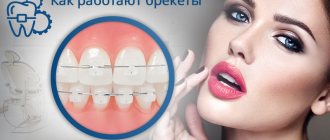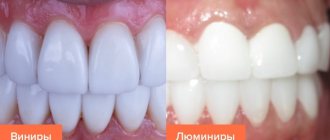Reading time 7-8 minutes
Author of the article: Tsurkan Victoria Olegovna
Specialization: Dentist-orthodontist
Total work experience: since 2015
- Stages of defect correction and expected results
- How long should you wear traction braces?
- Brief summary
When deciding on the use of orthodontic structures, patients are often interested in how long they wear braces on their teeth. Since the timing is determined individually, it is important to answer the question of what affects the duration of wear and what results to expect during the treatment process and after its completion.
People around you start to envy you kindly
Not many people can boast of a perfect smile, but only a few take on this problem. However, braces on an adult are causing others to think about going to the dentist again. Yes, people around you will pay attention to you more often; friends and acquaintances will begin to be interested in the details of the treatment, the sensations, and the cost of the design. One thing is for sure - they will respect you, because you care about your health and did what many do not dare to do. In addition, not everyone is ready to shell out more than 100 thousand rubles to correct their smile.
At what age is it easiest and fastest to get the desired result?
As a rule, an orthodontist will recommend putting braces on a child at the age of 10–12 years, when the formation of the maxillofacial apparatus is completed and the body is in the stage of active growth. But quite often doctors have to carry out corrections for preschoolers using removable orthodontic structures or postpone treatment with braces until they reach 16–18 years of age.
- Faster results of correction in adolescence are explained by greater compliance of the jaw bone.
- In children with baby teeth, the desired result can often be achieved by wearing a removable mouthguard or trainer. In adults, the same devices cope with only the most minor anomalies.
- Moreover, children whose jaw is just developing benefit from massage and specialized gymnastics that train the muscles of the face and tongue.
There are other features that significantly increase the cost and prolongation of orthodontic treatment for adults and even make it impossible.
Reaching a new goal
Perhaps you are faced with a difficult choice: on the one hand, you are embarrassed about your smile, on the other, you do not want to wear braces for 1 to 3 years. But the faster you start, the faster you finish. As they say, the best time to do this is yesterday, the second best time is today. Moreover, you will experience great joy as you systematically move towards your goal, seeing how your teeth are straightened month after month, and in the end you will get the long-awaited result - a beautiful smile. This experience will certainly be useful in other areas of life.
How long should you wear traction braces?
Rods are special rubber rings that are used for 4-5 months of treatment and are put on the structure separately. The main purpose is to enhance the thrust of the power arc. In this way, you can achieve faster and better results. It is noteworthy that, depending on the clinical case, different times are prescribed for how long these elastic bands should be worn during the day - in some cases they are placed only at night, and in others – around the clock.
The rods can be secured to the teeth in the following ways:
- on the upper and lower jaws on identical units;
- on four “square” – on 2 at the top and bottom;
- on three “triangles” - 2 on one jaw and 1 on the second;
- combining several of the methods described above at once.
The length of time to wear traction is determined individually. On average – from several months to six months.
Pros and cons of aligners and braces in use
Comparing aligners and braces allows you to understand the question of which technology is best to choose in your case. Each technology has its own advantages and disadvantages, and for convenience we will summarize them in a table.
| Comparison options | Aligners | Braces |
| Appearance | Transparent aligners | Locks. glued to the teeth, and a metal arch connecting them |
| Color | Transparent | Any |
| Material | Polymer | Metal/Polymer/Ceramics |
| Allergenicity | No | Yes |
| Are they suitable for children? | No | Yes |
| 3D modeling of jaws on a computer | Yes | No |
| Discussion with the doctor of the result and patient participation in treatment | Yes | No |
| Preparation time | 7 days | 1-2 days |
| Installation time | 45-60 minutes | 3-6 hours |
| Taking impressions before installation | Oral scan + impressions | Yes |
| Treatment speed | 30% faster | Slower |
| Impact mechanics | Simultaneous rotation and displacement of the tooth in the desired direction due to tight coverage | Consecutive displacement in one direction or another and rotation |
| Risk of caries | No | Yes |
| Possibility of enamel remineralization | Yes | No |
| Possibility of injury to the mucous membrane | No | Yes |
| Frequency of visits to the doctor for correction | Every 4-6 weeks | Every 2 weeks |
| Dietary restrictions during treatment | Almost not | Yes |
| Possibility to remove the structure for eating or cleaning | Yes | No |
| Food getting stuck between teeth | No | Yes |
| Bad breath after eating | No | Yes |
| Difficulty in oral hygiene | No | Yes |
| The need to brush your teeth after every meal | No | Yes |
| The need to use dental floss and toothpicks | If necessary | Necessarily |
| Using a special toothbrush | No | Yes |
| Toothbrush lifespan | Standard | Short (due to increased wear) |
| Opportunity to see results before treatment begins | Yes | No |
| Need to be worn constantly | No | Yes |
| Psychological comfort and self-esteem | Yes | No |
| Aesthetics of appearance | High | Low |
| Feeling of discomfort | No | Yes |
| Possibility of pain at the beginning of treatment | No | Yes |
| Impaired diction | Almost not | Yes |
| Protecting teeth from injury | Yes | No |
| Ease of installation and wearing | Yes | No |
| Possibility of self-replacement | Yes | No |
| Possibility of peeling off | No | Yes |
| Disruption of the usual way of life and forms of communication | No | Yes |
As can be seen from the above comparison, aligners are more convenient in almost everything. Braces cause more discomfort, require changes in the usual lifestyle and diet, and, in fact, the only case when braces are preferable is when the patient is a child. Therefore, when choosing between braces or aligners, according to the orthodontist, it is better to prefer aligners.
How do braces work?
Naturally, the doctor works with each patient individually. There are many types of braces, as well as many types of malocclusions. Already during the consultation, it becomes clear what problem is relevant and how to solve it.
How do braces work? After choosing a design, the doctor will carefully place the lock in the desired position on each tooth. Here it is important to take into account not only the position of individual teeth, but also the condition of the entire row. After all, even a small change in the position of one element leads to a displacement of all the others. Therefore, it is extremely important to configure everything correctly.
During treatment, the patient must regularly visit the doctor for preventive and corrective examinations. As the correction progresses, the doctor will gradually move the braces, adapting them to the new position of the teeth.
Is it possible to get braces if you have periodontitis?
Periodontitis, inflammatory gum disease, and malocclusion are two sides of the same coin.
- A malocclusion is often characterized by crowded teeth. At the same time, their high-quality cleaning from food debris and plaque is significantly difficult, and the likelihood of the formation of tartar, the main cause of periodontitis, is increased. Without eliminating the dental anomaly, it is impossible to cure inflammation of periodontal tissues.
- Of course, in the acute stage of the disease, orthodontic treatment cannot be carried out. The patient will first be prescribed professional teeth cleaning and therapeutic treatment, and only after that will the braces be installed.
Straightening teeth with braces for periodontitis has a number of distinctive features. In particular, the traction force of the orthodontic arch will be reduced, therefore, the treatment period will increase. You will also have to wear retainers longer than usual. In addition, the patient must especially carefully perform hygiene procedures. Only if these conditions are met, bite correction will play a positive role and stop the progression of periodontitis.
Unfortunately, significant degenerative processes in the periodontium, in particular, strong resorption of bone interradicular septa, can become a contraindication to bite correction with braces.
What are braces and who are they for?
We have known about braces for quite a long time - both in life and in movies we have seen people with characteristic braces on their teeth. Essentially, braces consist of small clasps glued to the teeth with special dental glue, and a metal arch passing through them, connecting them into a single system.
The archwire transfers pressure to the teeth, which causes the misaligned teeth to gradually shift toward a more correct position. As the defects are corrected, the arch must be tightened: for this, the patient needs to visit the dentist once every 2 weeks, and after treatment is completed, he also needs to wear special retainers that will prevent the possibility of reverse displacement of the straightened teeth.
At the same time, there is another method - the use of aligners. What is the difference between braces and aligners? Aligners are transparent aligners made of special plastic that fit tightly onto the teeth and create the necessary pressure to correct misaligned teeth. Speaking about the difference between braces and aligners, it can be noted that braces create many inconveniences in everyday life: they are clearly visible from the outside, they must be thoroughly cleaned after every meal, they are difficult to get used to and serious dietary restrictions must be observed during the period. wearing them.
However, in case of serious malocclusion, it is necessary to wear braces. In addition, aligners are usually used only for adults who have completed their period of jaw growth, although aligners are now being developed for children over 7 years of age. Braces do not have such a limitation - they can be placed on children at almost any age.
In addition, there is a difference between braces and aligners in the force of impact: braces are a more rigid structure that puts more pressure on the teeth, so they can be used to correct more complex situations.
TOP 5 fears of patients
Let's look at the main fears that make patients doubt whether to put braces on their jaw. Some of them are partly justified, some are not.
- For a long time. Yes, correcting a bite is not quick; treatment in adulthood takes an average of 1.5-2 years. But the result is worth it! Already in the first few months you will notice positive changes that will brighten up the period of wearing braces. Be a little patient, soon your dream of a beautiful smile will become a reality, and the question of whether you need to get braces will no longer be relevant!
- Noticeable. Most often, this question is relevant for girls and worries more than painful sensations when wearing. For patients who are concerned about the aesthetics of their smile, less noticeable systems have been developed - ceramic and sapphire braces, which are not so noticeable compared to standard metal ones. There are also invisible lingual braces that are attached to the back of the teeth, so the visual component is not a problem.
- Hurt. Unpleasant sensations while wearing braces are possible, but they are typical only for certain periods. Firstly, installing braces and getting used to them for the first 1-2 weeks. Secondly, correction of braces, which will be performed by an orthodontist approximately every 4-8 weeks. During the rest of the period after getting used to it, the structures will be almost not felt.
- Difficult to care for. During the period of wearing orthodontic systems, you will need to give up certain foods and drinks, and also pay special attention to oral hygiene. Yes, this is more labor-intensive than simply brushing your teeth, but patients quickly get used to this process, and it no longer causes as much discomfort as it might seem at the first stage.
- There will be no result. If you choose a competent orthodontist and follow all his recommendations, you will definitely get a beautiful, even smile as a result. Yes, this path requires time and effort, but it is better to decide and do it than to spend your whole life thinking about how to correct crooked teeth.
We start with the upper front teeth
On the upper front teeth, all the composite and all the material from the teeth were almost completely removed. On the fours and fives on top we only had roots. The front teeth were also not distinguished by the presence of large tissues; we also only had roots. Except for tooth 2.2, tooth 2.2 was alive. That is, of the top 10 teeth with which we worked, only 3 teeth were alive, and 7 were previously depulped.
It turns out we had 4 chewing teeth of which only the root remained, and all the composite fillings were removed from the 3 front teeth; they went almost to the root.
We slightly drilled the root canal
in order to install single-module veneers with the root part.
See what veneers look like with the root
:
Features of treating crooked teeth for veneers in the lower jaw
By the time the lower teeth were turned, we had already prepared a project, which I relied on - we displayed it on a huge 43-inch monitor. We did something incredible. Taking into account gum correction (the gum was corrected at tooth 1.1)
Below was a very complex project. After we sharpened we received photographs and a real view of the lower teeth
:
Once trimmed, it looked incredible. It felt like the teeth were completely straight from the start.
Despite the fact that the lower teeth were actually very crooked, we were able to build the ideal geometry of the dentition. Some teeth, such as 3.1, we “pushed” inward a little, and then did the same with teeth 4.1, 4.3 and 3.3.
We filed down the central lower teeth very much from the inside ( BUT!
We didn’t reach the nerve). We “moved” teeth 3.2 and 4.2 outward, filing down their inner part. As a result, as I said earlier, we did not depulpate a single tooth.
The teeth from below, from fang to fang, look quite even, that is, we managed to reach an even plane, an even line. Since we ground teeth 3.2 and 4.2 both inside and out, we decided to make practically crowns on them, that is, the contact points between the teeth remained intact, and the front and back parts were ground as if for a crown.
Braces in adults
The most favorable age range for correcting malocclusion is 12-18 years. During this period, all permanent teeth have already erupted, but the active growth phase continues. It is generally accepted that up to the age of 18, orthodontic treatment will take a minimum of time and be most effective. But it is not so. In many ways, the successful outcome of treatment and the time it takes to correct the bite depend on the patient: how responsibly he approaches the process, follows the recommendations of the orthodontist, and makes regular visits to the clinic. Adults are more scrupulous in this matter compared to teenagers, so wearing braces also brings the desired result.
Bite correction in adulthood is often indicated for patients not only for aesthetic reasons, although the desire to get a beautiful smile is in most cases the main reason for visiting an orthodontist. In addition to dissatisfaction with appearance and self-doubt, malocclusion often causes health problems: pain in the jaw, abrasion of enamel, gastrointestinal diseases due to poor chewing of food, headaches due to compression of joints and nerve endings.
So is it necessary to get braces? In 95% of cases the answer is “Yes!” The exception is contraindications and individual patient characteristics, which we will talk about later. All that remains is to dispel your basic fears and take a step towards a beautiful smile!
Braces or aligners? No, veneers!
After conducting digital diagnostics, I eventually told her that it was theoretically possible to install veneers while maintaining a normal bite. Everything can be done provided that your joint does not hurt, nothing crunches, everything is comfortable for you and absolutely nothing bothers you.
And we decided to try to make her a digital project, in which we will see if we can install veneers with such crooked teeth. That is, can we do the work on the veneers, place them evenly enough so that she likes it?
Also in the project you can see some footage where the doctor understood how much the lower teeth needed to be ground down in order to get an even lower dentition, that is, how much each tooth needed to be ground down minimally in order to get an even dentition.
Why was it necessary to sharpen the teeth as little as possible?
So as not to reach the nerve. Because when we carried out the work, we almost reached the nerve, but even in such a serious crooked situation with the teeth (they were looking in different directions), we did not depulpate a single tooth and received an absolutely even dentition.
We made casts and a photographic protocol. I initially saw that the teeth were as crooked as possible, but I always knew that no matter what “crooked” situation we found ourselves in, everything always turned out smooth. In Maria’s situation, my experience told me that it would turn out quite smoothly and nothing should bother her, taking into account the fact that we will be covering 20 teeth with veneers - 10 on top
and
10 from below
.
Moving to another city is another difficulty in orthodontic treatment for adults
In the photo before and after braces, even a non-specialist can clearly see how the position of the teeth and the nature of the bite improve during the process of orthodontic treatment. But, unfortunately, the result of the correction sometimes leaves much to be desired, and this is not always due to the lack of qualifications of the dentist. In the case of older patients, problems often arise due to their frivolous attitude towards the extremely complex process of teeth straightening.
If the situation is such that a person moves to another city for family or work reasons, therapy is usually interrupted for an indefinite period, so the achieved result is quickly lost and the teeth move in different directions.
Types of bracket systems
Orthodontic systems are divided into external (vestibular) and internal (lingual).
— External braces are the most common option. The most popular systems are metal, ceramic, sapphire. Metal braces are characterized by the lowest price, but they are most noticeable on the teeth. Ceramic and sapphire ones are not so striking, but their cost is higher.
— Lingual braces are structures that are installed on the back wall of the teeth and are completely invisible when smiling. Because of this, the system is often of interest, but this option has a number of disadvantages: difficult care, possible injuries to the tongue and mucous membranes, extended wearing time, and the highest price.











